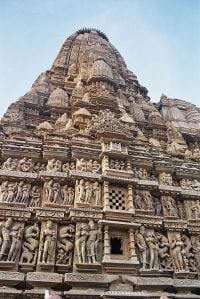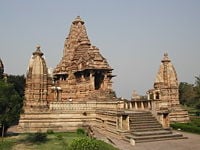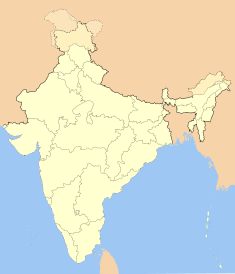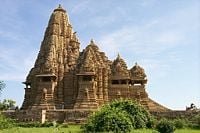Difference between revisions of "Khajuraho" - New World Encyclopedia
Dan Davies (talk | contribs) (imported, credited, claimed) |
Dan Davies (talk | contribs) (started tag) |
||
| Line 1: | Line 1: | ||
| − | {{claimed}} | + | {{started}}{{claimed}} |
{{Infobox World Heritage Site | {{Infobox World Heritage Site | ||
| WHS = Khajuraho Group of Monuments | | WHS = Khajuraho Group of Monuments | ||
| − | | Image = [[Image:Khajuraho5.jpg| | + | | Image = [[Image:Khajuraho5.jpg|200px|A typical temple at Khajuraho with divine couples. Note lace-like ornamentation on the major and the minor shikharas.]] |
| State Party = {{IND}} | | State Party = {{IND}} | ||
| Type = Cultural | | Type = Cultural | ||
| Line 20: | Line 20: | ||
==History== | ==History== | ||
| − | The city was once the original capital of the [[Chandela]] [[Rajput]]s, a Hindu dynasty that ruled this part of India from the 10th to the 12th centuries. The Khajuraho temples were built over a span of a hundred years, from | + | The city was once the original capital of the [[Chandela]] [[Rajput]]s, a Hindu dynasty that ruled this part of India from the 10th to the 12th centuries. The Khajuraho temples were built over a span of a hundred years, from 950 to 1050. The Chandela capital was moved to [[Mahoba]] after this time, but Khajuraho continued to flourish for some time. |
The whole area was enclosed by a wall with eight gates, each flanked by two golden palm trees. There were originally over 80 Hindu temples, of which only 22 now stand in a reasonable state of preservation, scattered over an area of about 8 square miles (21 km²). | The whole area was enclosed by a wall with eight gates, each flanked by two golden palm trees. There were originally over 80 Hindu temples, of which only 22 now stand in a reasonable state of preservation, scattered over an area of about 8 square miles (21 km²). | ||
| Line 58: | Line 58: | ||
== Architecture == | == Architecture == | ||
The Khajuraho temples, constructed with spiral superstructures, adhere to a northern Indian [[shikhara]] temple style and often to a [[Panchayatana]] plan or layout. A few of the temples are dedicated to the [[Jain]] pantheon and the rest to Hindu deities - to God's Trio, [[Brahma]], [[Vishnu]] and [[Shiva]], and various [[Devi]] forms, such as the [[Devi Jagadambi temple]]. A Panchayatana temple had four subordinate shrines on four corners and the main shrine in the center of the podium, which comprises their base. The temples are grouped into three geographical divisions: western, eastern and southern. | The Khajuraho temples, constructed with spiral superstructures, adhere to a northern Indian [[shikhara]] temple style and often to a [[Panchayatana]] plan or layout. A few of the temples are dedicated to the [[Jain]] pantheon and the rest to Hindu deities - to God's Trio, [[Brahma]], [[Vishnu]] and [[Shiva]], and various [[Devi]] forms, such as the [[Devi Jagadambi temple]]. A Panchayatana temple had four subordinate shrines on four corners and the main shrine in the center of the podium, which comprises their base. The temples are grouped into three geographical divisions: western, eastern and southern. | ||
| + | [[Image:Khajuraho-Lakshmana temple.JPG|left|thumb||200px|Lakshmana temple at Khajuraho, a [[panchayatana]] temple. Two of the four secondary shrines can be seen. [http://commons.wikimedia.org/wiki/Image:Khajuraho_tempel_india.jpg Another view]]] | ||
With a graded rise secondary shikharas (spires) cluster to create an appropriate base for the main shikhara over the sanctum. [[Kandariya Mahadeva]], one of the most accomplished temples of the Western group, comprises eighty-four shikharas, the main being 116 feet from the ground level. | With a graded rise secondary shikharas (spires) cluster to create an appropriate base for the main shikhara over the sanctum. [[Kandariya Mahadeva]], one of the most accomplished temples of the Western group, comprises eighty-four shikharas, the main being 116 feet from the ground level. | ||
| − | + | These shikharas—subordinate and main—attribute to the Khajuraho temples their unique splendor and special character. With a graded rise of these shikharas from over the [[ardhamandapa]], porch, to [[mandapa]], assembly hall, [[mahamandapa]], principal assembly hall, [[antarala]], vestibule, and [[garbhagriha]], [[sanctum sanctorum]], the Khajuraho temples attain the form and glory of gradually rising [[Himalaya]]n peaks. These temples of Khajuraho have sculptures that look very realistic and are studied even today. | |
| − | These | ||
The [[Saraswathi]] temple on the campus of [[Birla Institute of Technology and Science]], [[Pilani]], India is modeled after the Khajuraho temple. | The [[Saraswathi]] temple on the campus of [[Birla Institute of Technology and Science]], [[Pilani]], India is modeled after the Khajuraho temple. | ||
| Line 72: | Line 72: | ||
==The statues and carvings of Khajuraho== | ==The statues and carvings of Khajuraho== | ||
| − | [[Image:Kandariya mahadeva temple.jpg|thumb|Kandariya Mahadeva temple]] | + | <!--[[Image:Kandariya mahadeva temple.jpg|thumb|Kandariya Mahadeva temple]]—> |
| + | [[Image:Khajuraho - Kandariya Mahadeo Temple.jpg|thumb|right|200px|View of Kandariya Mahadeo Temple (11th century) at Khajuraho (Madhya Pradesh, India)]] | ||
| + | The Khajuraho temples do not contain sexual or [[erotic art]] inside the temple or near the deities; however, some external carvings bear erotic art and [[Tantric sexuality|tantric sexual]] poses. Also, some of the temples that have two layers of walls have small erotic carvings on the outside of the inner wall. There are many interpretations of the erotic carvings. According to some current Hindu interpretations, they portray that, for seeing the deity, one must leave his or her sexual desires outside the temple. They also show that divinity, such as the deities of the temples, is pure like the [[Atman (Hinduism)|atman]], which is not affected by sexual desires and other characteristics of the physical body. Meanwhile, the external curvature and carvings of the temples depict humans, human bodies, and the changes that occur in human bodies, as well as facts of life. Some 10% of the carvings contain sexual themes; those reportedly do not show deities, they show sexual activities between people. The rest depict the everyday life of the common Indian of the time when the carvings were made, and of various activities of other beings. For example, those depictions show women putting on makeup, musicians, potters, farmers, and other folks. Those mundane scenes are all at some distance from the temple deities. A common misconception is that, since the old structures with carvings in Khajuraho are temples, the carvings depict sex between deities.<ref>[http://www.liveindia.com/khajuraho/8a.html "Khajurajo," liveindia.com]</ref> | ||
| − | + | Between 950 and 1050, the Chandela monarchs, followers of the [[Tantra|Tantric]] tradition, built these temples. Adherents of Tantrism teach that gratification of earthly desires is a step towards accomplishing [[Nirvana]]. In olden days, before the [[Mughal]] conquests, when boys lived in hermitages, following ''[[brahmacharitva]]'' until they became men, they could learn about the world and prepare themselves to become householders through examining these sculptures and the worldly desires they depicted.<ref>[http://www.cultureholidays.com/Temples/khajuraho.htm Article on Khajuraho Temples]—Accessed on March 06, 2007</ref> | |
| − | |||
| − | Between | ||
==References== | ==References== | ||
Revision as of 20:15, 4 November 2007
| Khajuraho Group of Monuments* | |
|---|---|
| UNESCO World Heritage Site | |

| |
| State Party | |
| Type | Cultural |
| Criteria | i, iii |
| Reference | 240 |
| Region** | Asia-Pacific |
| Inscription history | |
| Inscription | 1986 (10th Session) |
| * Name as inscribed on World Heritage List. ** Region as classified by UNESCO. | |
Khajuraho (Hindi खजुराहो) is a village in the Indian state of Madhya Pradesh, located in Chhatarpur District, about 385 miles (620 kilometres) southeast of Delhi, the capital city of India.
The Khajuraho group of monuments has been listed as a UNESCO World Heritage Site.
One of the most popular tourist destinations in India, Khajuraho has the largest group of medieval Hindu and Jain temples, famous for their erotic sculpture. The name Khajuraho is derived from the Hindi word khajur meaning date palm.
History
The city was once the original capital of the Chandela Rajputs, a Hindu dynasty that ruled this part of India from the 10th to the 12th centuries. The Khajuraho temples were built over a span of a hundred years, from 950 to 1050. The Chandela capital was moved to Mahoba after this time, but Khajuraho continued to flourish for some time.
The whole area was enclosed by a wall with eight gates, each flanked by two golden palm trees. There were originally over 80 Hindu temples, of which only 22 now stand in a reasonable state of preservation, scattered over an area of about 8 square miles (21 km²).
Unlike other cultural centers of North India, the temples of Khajuraho never underwent massive destruction and a number of them have survived. They are fine examples of Indian architectural styles that have gained popularity due to their salacious depiction of the traditional way of life during medieval times. They were rediscovered during the late 19th century and the jungles had taken a toll on some of the monuments.
Geography
Khajuraho is located at [1]. It has an average elevation of 283 metres (928 feet).
Demographics
| Khajuraho Madhya Pradesh • India | |
| Coordinates: | |
| Time zone | IST (UTC+5:30) |
| Area • Elevation |
• 283 m (928 ft) |
| District(s) | Chhatarpur |
| Population | 19,282 (2001) |
Coordinates:
As of 2001 India census[2], Khajuraho had a population of 19,282. Males constitute 52% of the population and females 48%. Khajuraho has an average literacy rate of 53%, lower than the national average of 59.5%: male literacy is 62%, and female literacy is 43%. In Khajuraho, 19% of the population is under 6 years of age.
Architecture
The Khajuraho temples, constructed with spiral superstructures, adhere to a northern Indian shikhara temple style and often to a Panchayatana plan or layout. A few of the temples are dedicated to the Jain pantheon and the rest to Hindu deities - to God's Trio, Brahma, Vishnu and Shiva, and various Devi forms, such as the Devi Jagadambi temple. A Panchayatana temple had four subordinate shrines on four corners and the main shrine in the center of the podium, which comprises their base. The temples are grouped into three geographical divisions: western, eastern and southern.

]
With a graded rise secondary shikharas (spires) cluster to create an appropriate base for the main shikhara over the sanctum. Kandariya Mahadeva, one of the most accomplished temples of the Western group, comprises eighty-four shikharas, the main being 116 feet from the ground level.
These shikharas—subordinate and main—attribute to the Khajuraho temples their unique splendor and special character. With a graded rise of these shikharas from over the ardhamandapa, porch, to mandapa, assembly hall, mahamandapa, principal assembly hall, antarala, vestibule, and garbhagriha, sanctum sanctorum, the Khajuraho temples attain the form and glory of gradually rising Himalayan peaks. These temples of Khajuraho have sculptures that look very realistic and are studied even today.
The Saraswathi temple on the campus of Birla Institute of Technology and Science, Pilani, India is modeled after the Khajuraho temple.
Landscape
The Khajuraho temples are now set in a parkland landscape. When India gained independence from Britain in 1947 the landscape setting was semi-desert and scrub. The archaeological park now has something of the character of an English public park, with mown grass, rose beds and ornamental trees. This may be popular with visitors but has no relationship with the historic landscape at the time the temples were built.
The development of landscape archaeology as an academic discipline raises questions concerning the earlier landscape of Khajuraho and the original relationship between the temple complex and the surrounding area. There are no records of what the original landscape might have been, but it is known that a large community of priests used the temple complex and that Indian gardens in the tenth century were predominantly tree gardens. They did not have lawns or herbaceous flowering plants.
The statues and carvings of Khajuraho
The Khajuraho temples do not contain sexual or erotic art inside the temple or near the deities; however, some external carvings bear erotic art and tantric sexual poses. Also, some of the temples that have two layers of walls have small erotic carvings on the outside of the inner wall. There are many interpretations of the erotic carvings. According to some current Hindu interpretations, they portray that, for seeing the deity, one must leave his or her sexual desires outside the temple. They also show that divinity, such as the deities of the temples, is pure like the atman, which is not affected by sexual desires and other characteristics of the physical body. Meanwhile, the external curvature and carvings of the temples depict humans, human bodies, and the changes that occur in human bodies, as well as facts of life. Some 10% of the carvings contain sexual themes; those reportedly do not show deities, they show sexual activities between people. The rest depict the everyday life of the common Indian of the time when the carvings were made, and of various activities of other beings. For example, those depictions show women putting on makeup, musicians, potters, farmers, and other folks. Those mundane scenes are all at some distance from the temple deities. A common misconception is that, since the old structures with carvings in Khajuraho are temples, the carvings depict sex between deities.[3]
Between 950 and 1050, the Chandela monarchs, followers of the Tantric tradition, built these temples. Adherents of Tantrism teach that gratification of earthly desires is a step towards accomplishing Nirvana. In olden days, before the Mughal conquests, when boys lived in hermitages, following brahmacharitva until they became men, they could learn about the world and prepare themselves to become householders through examining these sculptures and the worldly desires they depicted.[4]
ReferencesISBN links support NWE through referral fees
- ↑ Falling Rain Genomics, Inc - Khajuraho
- ↑ GRIndia
- ↑ "Khajurajo," liveindia.com
- ↑ Article on Khajuraho Temples—Accessed on March 06, 2007
Further reading
- Phani Kant Mishra, Khajuraho: With Latest Discoveries, Sundeep Prakashan (2001) ISBN 8175741015
See also
- Kandariya Mahadeva
- Hemvati
- Kalinjar
- Beejamandal
- Jain temples of Khajuraho
External links
- UNESCO World Heritage Site Listing
- Love, The Living Spirit of Khajuraho by Prof. P. C. Jain and Dr. Daljeet.
- Travel guide to Khajuraho from Wikitravel
| |||||||
Credits
New World Encyclopedia writers and editors rewrote and completed the Wikipedia article in accordance with New World Encyclopedia standards. This article abides by terms of the Creative Commons CC-by-sa 3.0 License (CC-by-sa), which may be used and disseminated with proper attribution. Credit is due under the terms of this license that can reference both the New World Encyclopedia contributors and the selfless volunteer contributors of the Wikimedia Foundation. To cite this article click here for a list of acceptable citing formats.The history of earlier contributions by wikipedians is accessible to researchers here:
The history of this article since it was imported to New World Encyclopedia:
Note: Some restrictions may apply to use of individual images which are separately licensed.


